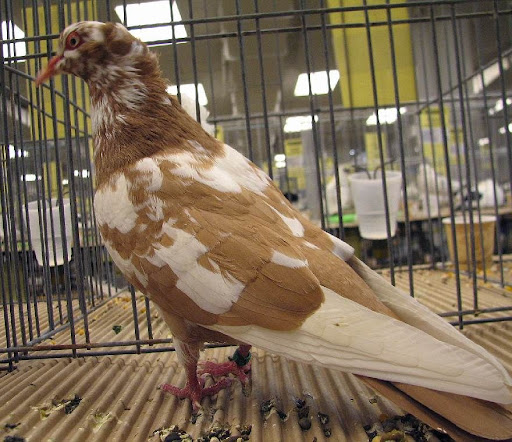| Scene from On the Waterfront. Courtesy Indywire. |
Q: Tell us about your pigeons.
A: I have flight pigeons; the idea with flights is that you fly them around from your roof. You have a stick topped with a rag or a bag that you wave at the birds. Other people will fly their pigeons from other roofs, sometimes five or six blocks away. The idea is when all the birds are flying; you try to catch as many birds as you can from the other owners. You use the stick to draw in your bird and the other birds; then you walk them into their coops. It is war in the air. You can be friends on the street but it’s war on the roof.
Q: Do you have names for your pigeons?
A: We don’t name them, but the name is within the color of the birds. If it’s yellow in color, it’s called a Yellow Flight. If it’s a bird with two colors blended, it’s called a teager.
 |
| A yellow teager. Courtesy Steve. |
Q: How many pigeons do you have?
A: Right now I have approximately 150 birds. At one time, I had up to 1500 birds.
Q: How long have you been keeping them?
A: I’ve been doing this for around thirty-five years.
Q: How were you drawn to pigeon keeping?
A: In my neighborhood growing up, there was a man who had pigeons. He was older, around sixty. I was drawn to the pigeons and went on his roof. I would help clean them, feed them, and take care of them.
Q: Is this something your family does?
A: No, I’m the only hobbyist in the family.
Q: Where do you keep your birds?
A: They are in Brooklyn, on the roof of my friend’s home. I visit them every day because I need to feed and water the birds. I could never leave them; I would miss them too much.
Q: Have you raced pigeons in the past?
A: No, I just do flights. Racing pigeons is very time-consuming. You must have a schedule to train the birds.
Q: Is there anything else you would like to add?
A: I would like people to know that the pigeons we keep are very different from the pigeons in the streets. Pigeons in the streets are known “street rats.” The pigeons we keep are of all different varieties.
To watch flight pigeons in action, watch this film clip entitled “Up on the Roof.” (Benny has a cameo!)
And more pigeon talk tomorrow night at 6:30 PM. In addition to filmmaker Annie Heringer, who'll show clips from her documentary, you'll also meet Marty McGuinniss, who has had birds since he could walk and has become one of the top pigeon fliers in NYC.
Join us at the Museum Shop, 108 Orchard Street at Delancey.
- Interview by Alana Rosen































